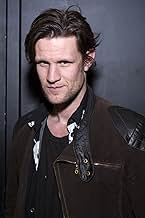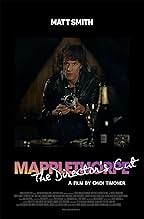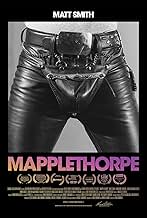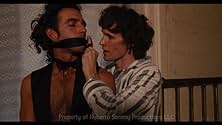Una mirada a la vida del fotógrafo Robert Mapplethorpe, desde su llegada a la fama en los 70 hasta su muerte en 1989.Una mirada a la vida del fotógrafo Robert Mapplethorpe, desde su llegada a la fama en los 70 hasta su muerte en 1989.Una mirada a la vida del fotógrafo Robert Mapplethorpe, desde su llegada a la fama en los 70 hasta su muerte en 1989.
- Dirección
- Guionistas
- Elenco
- Premios
- 8 premios ganados y 4 nominaciones en total
Karlee Leilani Perez
- Lisa Lyon
- (as Karlee Perez)
- Dirección
- Guionistas
- Todo el elenco y el equipo
- Producción, taquilla y más en IMDbPro
Opiniones destacadas
"Mapplethorpe" (2018 release; 102 min.) is a biographical movie about the life and times of controversial photographer Robert Mapplethorpe. As the movie opens, we are told it is "Pratt Institute, Brooklyn, New York, 1969", where a young Robert Mapplethorpe looks utterly bored. Next thing, we are in Manhattan, where Mapplethorpe is bouncing from place to place, and he is refused entrance to the Whitney Museum as he can't afford the $1 admission. Then one day, at the park, a young lady comes up to him asking for help. Turns out to be Patti Smith. They hit it of right away, and it's not long before they move in together at the Chelsea Hotel. By happenstance, another tenant there introduces Robert to a Polaroid camera... At this point we're less than 15 min. into the movie, and you;ll just have to see for yourself how it all plays out.
Couple of comments: this movie is written and directed by Ondi Timoner, best known for her music documentary "DIG!". As soon as I saw her name attached to "Mapplethorpe", I was pretty reasonably confident that we'd get a good movie. And it is a good enough, although by no means great, movie. The challenge faced by Timoner is how to bring the controversial sides (yes, in plural) of Mapplethorpe, both as to his personal life and as to his art, to the screen, without diluting the essence of the man and his work. In my book, Timoner strikes a good balance. The movie benefits greatly from the incredible performance by British actor Matt Smith in the title role. He really makes you believe that we are looking at the real Mapplethorpe. Beware: the movie contains a fair amount of nudity, mostly male nudity I might add. The early years between Mapplethorpe and Smith have also been covered in Patti Smith's brilliant memoir "Just Kids" (much better than this film, frankly). It is hard to believe that 2019 marks the 30th anniversary of Mapplethorpe's death... The movie's closing credits reference "The Perfect Moment" traveling exhibit later in 1989-90, where upon its exhibition at the Contemporary Arts Center here in Cincinnati in Spring of 1990, the CAC was charged with obscenity, the first museum ever to face such a charge, the movie reminds us. The CAC was subsequently acquitted by a unanimous jury, but the film makers "accidentally forget" to mention this in the movie's closing credits...
"Mapplethorpe" premiered at last year's Tribeca film festival to positive acclaim, and finally was released in theaters this weekend. The Saturday early evening screening where I saw this at my art-house theater here in Cincinnati, was attended okay but not great (about 20 people). Following the screening, there was an insightful, free-flowing half hour Q&A session with Louis Sirkin, the Cincinnati lawyer who successfully defended the CAC against that obscenity indictment. If you have any interest in controversial art and a controversial artist, I'd readily suggest you check this out, be it in the theater, on VOD, or eventually on DVD/Blu-ray, and draw your own conclusion
Couple of comments: this movie is written and directed by Ondi Timoner, best known for her music documentary "DIG!". As soon as I saw her name attached to "Mapplethorpe", I was pretty reasonably confident that we'd get a good movie. And it is a good enough, although by no means great, movie. The challenge faced by Timoner is how to bring the controversial sides (yes, in plural) of Mapplethorpe, both as to his personal life and as to his art, to the screen, without diluting the essence of the man and his work. In my book, Timoner strikes a good balance. The movie benefits greatly from the incredible performance by British actor Matt Smith in the title role. He really makes you believe that we are looking at the real Mapplethorpe. Beware: the movie contains a fair amount of nudity, mostly male nudity I might add. The early years between Mapplethorpe and Smith have also been covered in Patti Smith's brilliant memoir "Just Kids" (much better than this film, frankly). It is hard to believe that 2019 marks the 30th anniversary of Mapplethorpe's death... The movie's closing credits reference "The Perfect Moment" traveling exhibit later in 1989-90, where upon its exhibition at the Contemporary Arts Center here in Cincinnati in Spring of 1990, the CAC was charged with obscenity, the first museum ever to face such a charge, the movie reminds us. The CAC was subsequently acquitted by a unanimous jury, but the film makers "accidentally forget" to mention this in the movie's closing credits...
"Mapplethorpe" premiered at last year's Tribeca film festival to positive acclaim, and finally was released in theaters this weekend. The Saturday early evening screening where I saw this at my art-house theater here in Cincinnati, was attended okay but not great (about 20 people). Following the screening, there was an insightful, free-flowing half hour Q&A session with Louis Sirkin, the Cincinnati lawyer who successfully defended the CAC against that obscenity indictment. If you have any interest in controversial art and a controversial artist, I'd readily suggest you check this out, be it in the theater, on VOD, or eventually on DVD/Blu-ray, and draw your own conclusion
I cannot say I am a Matt Smith fan because every time I see a project with him in it, it take a while for me to get Matt Smith off the screen and the character he is playing on it. It took an extra long time in this one to get rid of Matt Smith "playing" Robert Mapplethorpe and accept him as Robert Mapplethorpe. Too long to give the film a better rating than a 7. Had Matt disappeared MUCH sooner, it would have been an 8.
The film did show the progression of how Mapplethorpe morphed into a photographer instead of being another type of artist.
No, there wasn't a lot of Patti Smith, but it wasn't a film about her. I liked her time at the end with him.
This renewed my interest in Mapplethorpe and the pure language of art. It was interesting when he told his brother that he had no idea how he did what he did and that made a lot of sense.
This film is a must-see for anyone who appreciates art. Any kind of art.
The film did show the progression of how Mapplethorpe morphed into a photographer instead of being another type of artist.
No, there wasn't a lot of Patti Smith, but it wasn't a film about her. I liked her time at the end with him.
This renewed my interest in Mapplethorpe and the pure language of art. It was interesting when he told his brother that he had no idea how he did what he did and that made a lot of sense.
This film is a must-see for anyone who appreciates art. Any kind of art.
If this was a mainstream cinema release rather than a Gay film festival movie I suspect Matt Smith would have been included in all the major acting nominees for this years awards.
Matt Smit gives an amazing performance as Michael Mapplethorpe the famous art photographer for the late 1960's 1970's.
Of course he was a cultural gay icon and the movie does show his famous male erotic photos as well as the beautiful floral subjects he also photographed. It was the era in New York if promiscuous sex when thousands of men died of AIDS including Mapplethorpe who died in 1989 age 42.
Mapplethorpe says in the movie That he wouldn't reach the age of 50 but he hoped he'd be famous before he dies and he was correct on both counts.
The film won 7 audience awards at International Film Festivals and it's easy to understand why as Director Ondi Timoner and the great supporting cast especially Marianne Rendon as Patti Smith and Brandon Sklenar as Edward Mapplethorpe Roberts brother have contributed to make a very interesting and entertaining movie that should be seen by all just not the GLBTQI audiences.
If male erotic nudity in photography or mild homosexual sexual content offends this movie is not for you but as I watched this film I thought of all explicit heterosexual sexual content in films our community sits through and it made me think if one day so called GLBTQ movies will be shown alongside mainstream movies and therefore gain a much wider audience. I also wondered watching Mapplethorpe if the Art and Photography of that amazing psychedelic era of Mapplethorpe and Andy Warhol would be viewed as such valuable masterpieces if created today but I guess it's like saying that if a painter today painted like a renaissance master like Leonard Da Vinci or Michelangelo would we think it old fashioned ? We watched Matt Smith yesterday play another famous Gay cultural icon Christopher Isherwood in his 2011 movie Christopher and His Kind in which he plays another very different gay man and I agree with his stance of defending straight actors who play gay characters as far as I'm concerned it's the best actor to suit the part regardless of sexuality and Matt Smith I think is perfect in this role. Hi see it or catch it on DVD or stream release.
Of course he was a cultural gay icon and the movie does show his famous male erotic photos as well as the beautiful floral subjects he also photographed. It was the era in New York if promiscuous sex when thousands of men died of AIDS including Mapplethorpe who died in 1989 age 42.
Mapplethorpe says in the movie That he wouldn't reach the age of 50 but he hoped he'd be famous before he dies and he was correct on both counts.
The film won 7 audience awards at International Film Festivals and it's easy to understand why as Director Ondi Timoner and the great supporting cast especially Marianne Rendon as Patti Smith and Brandon Sklenar as Edward Mapplethorpe Roberts brother have contributed to make a very interesting and entertaining movie that should be seen by all just not the GLBTQI audiences.
If male erotic nudity in photography or mild homosexual sexual content offends this movie is not for you but as I watched this film I thought of all explicit heterosexual sexual content in films our community sits through and it made me think if one day so called GLBTQ movies will be shown alongside mainstream movies and therefore gain a much wider audience. I also wondered watching Mapplethorpe if the Art and Photography of that amazing psychedelic era of Mapplethorpe and Andy Warhol would be viewed as such valuable masterpieces if created today but I guess it's like saying that if a painter today painted like a renaissance master like Leonard Da Vinci or Michelangelo would we think it old fashioned ? We watched Matt Smith yesterday play another famous Gay cultural icon Christopher Isherwood in his 2011 movie Christopher and His Kind in which he plays another very different gay man and I agree with his stance of defending straight actors who play gay characters as far as I'm concerned it's the best actor to suit the part regardless of sexuality and Matt Smith I think is perfect in this role. Hi see it or catch it on DVD or stream release.
It is a shame that I will have to give this project a mediocre review, since I think the effort to tell Robert Mapplethorpe's story is admirable. Unfortunately, even though I am a fan of Ondi Timoner, the incredibly talented Director of We Live In Public, I would have to caution viewers to lower their expectations before entering the theater.
Perhaps what was most disappointing was the treatment of Patti Smith's character in the film. The actress, Marianne Rendon, was not up to the level that she should have been. The facts of the relationship are distorted, and the timeline also seems a bit off. In the movie, the character of Patti is working to support Robert; however, in real life, both of them worked to support each other. Patti gets annoyed with Robert (because of some unknown reason) and storms out, therefore, leaving Robert to find another lover/benefactor in the form of rich curator Sam Wagstaff -- yet in real life, Patti stayed with him quite a bit later on and was actually herself also funded by Sam Wagstaff when she went into a studio to record her first single. So the idea that Patti would never want to see or speak to Robert again is completely wrong, and Patti herself said publicly several times that what she and Robert had was much more than ordinary love. The scene of Patti walking out on Robert rings false, as does much of what Marianne has to work with. (I read her book Just Kids, her autobiography of that time, and it is quite clear that she would never have walked out of Robert's life, no matter what the outside circumstances.)
I had really hoped to see Patti and Robert creating the image of her first album cover (Horses), yet that scene seems to have been left out for some unknown reason. (Maybe a copyright issue?)
The film jumps forward quickly and does an awkward shift of Robert suddenly becoming famous and carrying his gripe against the world regardless of the fact that his photos are now being collected and respected. Oddly, he seems to be obsessed with the idea of "biting the hand that feeds him" on many occasions. Somehow, I feel this was an assumption by the writer and director and may not have actually been the real course of events. Robert is "discovered" (i.e., he sleeps with a guy who's rich) and the man who discovered him, Sam Wagstaff, is portrayed in the film as a gullible personality who falls under Robert's spell, and later on is prone to jealousy as Robert lives an obviously self-indulgent existence without a care in the world. As it is, Walstaff becomes quite successful and wealthy himself by the arrangement, and is therefore doubly compensated.
The lead actor, Matt Smith, does a professional job of portraying the famous photographer, and hits all the right notes. However, the material he gets to work with is all one-sided: apparently, according to the script, Robert Mapplethorpe could not get along with anyone, including none of his family members, not his first girlfriend (Patti Smith), not Sam Wagstaff, not a black man who was his muse named Milton, not his kid brother Edward, and of course, not his mother and father. In fact, (again, as the script dictates), he is painfully dropped by everyone -- and in one very "on the nose" moment, his "black muse" Milton says, "You don't love anyone but yourself" before smashing the famous photo that Robert took of him in the business suit -- and storming out of Robert's life -- of course, there is a bit of belief that needed to be suspended here.
As it is written, Robert Mapplethorpe is a crass, egotistic, over-hyped selfish brat who takes dirty pictures that are first, horribly rejected and later on, lavishly sought after by obnoxiously self-important and vain art dealers and critics. Yet, in spite of all that he achieves, and in spite of selling photos for thousands of dollars each, Robert is still living the life of a tortured artist. This leaves one to wonder, what exactly is his problem?
The scenes of Robert creating some of his famous photos are somewhat simplistic, i.e., the most that he seems to do to take a photo is to say "Cross your legs" and then "Put your arms out" -- as if it was just another day at the office. The scenes of some of the really erotic photos are about as exciting as someone taking wedding pictures (which, strangely enough, happens in a one scene set in San Francisco. As far as I can tell, Robert shot even Weddings, as long as it paid well. If this was a cartoon, a giant question mark would appear right about this point in the film, as if to say, 'Huh, say whut?'.)
In watching the film version, one can't help but wonder why is such a major artist being given such a simplistic biography. Was the budget too small? Was it too hard to include some of the more controversial issues? Issues such as the famous censorship case with the American Family Association (they declared his photos to be pornography) -- which, in hindsight, legitimized his work, and the resulting publicity pushed his fame into the public consciousness.
Surely a talented biographer as Ondi Timoner must have seen the irony of this series of events: unknown photographer takes erotic photos, no one takes any notice; the religious right denounces them, and suddenly everyone wants to see them -- bingo, instant fame. The story is really about our collective bigotry. We are all subject to the same fault: one only wants something when an authority figure tells us we can't have it. That's Ondi's territory -- and she does it so well.
Perhaps what was most disappointing was the treatment of Patti Smith's character in the film. The actress, Marianne Rendon, was not up to the level that she should have been. The facts of the relationship are distorted, and the timeline also seems a bit off. In the movie, the character of Patti is working to support Robert; however, in real life, both of them worked to support each other. Patti gets annoyed with Robert (because of some unknown reason) and storms out, therefore, leaving Robert to find another lover/benefactor in the form of rich curator Sam Wagstaff -- yet in real life, Patti stayed with him quite a bit later on and was actually herself also funded by Sam Wagstaff when she went into a studio to record her first single. So the idea that Patti would never want to see or speak to Robert again is completely wrong, and Patti herself said publicly several times that what she and Robert had was much more than ordinary love. The scene of Patti walking out on Robert rings false, as does much of what Marianne has to work with. (I read her book Just Kids, her autobiography of that time, and it is quite clear that she would never have walked out of Robert's life, no matter what the outside circumstances.)
I had really hoped to see Patti and Robert creating the image of her first album cover (Horses), yet that scene seems to have been left out for some unknown reason. (Maybe a copyright issue?)
The film jumps forward quickly and does an awkward shift of Robert suddenly becoming famous and carrying his gripe against the world regardless of the fact that his photos are now being collected and respected. Oddly, he seems to be obsessed with the idea of "biting the hand that feeds him" on many occasions. Somehow, I feel this was an assumption by the writer and director and may not have actually been the real course of events. Robert is "discovered" (i.e., he sleeps with a guy who's rich) and the man who discovered him, Sam Wagstaff, is portrayed in the film as a gullible personality who falls under Robert's spell, and later on is prone to jealousy as Robert lives an obviously self-indulgent existence without a care in the world. As it is, Walstaff becomes quite successful and wealthy himself by the arrangement, and is therefore doubly compensated.
The lead actor, Matt Smith, does a professional job of portraying the famous photographer, and hits all the right notes. However, the material he gets to work with is all one-sided: apparently, according to the script, Robert Mapplethorpe could not get along with anyone, including none of his family members, not his first girlfriend (Patti Smith), not Sam Wagstaff, not a black man who was his muse named Milton, not his kid brother Edward, and of course, not his mother and father. In fact, (again, as the script dictates), he is painfully dropped by everyone -- and in one very "on the nose" moment, his "black muse" Milton says, "You don't love anyone but yourself" before smashing the famous photo that Robert took of him in the business suit -- and storming out of Robert's life -- of course, there is a bit of belief that needed to be suspended here.
As it is written, Robert Mapplethorpe is a crass, egotistic, over-hyped selfish brat who takes dirty pictures that are first, horribly rejected and later on, lavishly sought after by obnoxiously self-important and vain art dealers and critics. Yet, in spite of all that he achieves, and in spite of selling photos for thousands of dollars each, Robert is still living the life of a tortured artist. This leaves one to wonder, what exactly is his problem?
The scenes of Robert creating some of his famous photos are somewhat simplistic, i.e., the most that he seems to do to take a photo is to say "Cross your legs" and then "Put your arms out" -- as if it was just another day at the office. The scenes of some of the really erotic photos are about as exciting as someone taking wedding pictures (which, strangely enough, happens in a one scene set in San Francisco. As far as I can tell, Robert shot even Weddings, as long as it paid well. If this was a cartoon, a giant question mark would appear right about this point in the film, as if to say, 'Huh, say whut?'.)
In watching the film version, one can't help but wonder why is such a major artist being given such a simplistic biography. Was the budget too small? Was it too hard to include some of the more controversial issues? Issues such as the famous censorship case with the American Family Association (they declared his photos to be pornography) -- which, in hindsight, legitimized his work, and the resulting publicity pushed his fame into the public consciousness.
Surely a talented biographer as Ondi Timoner must have seen the irony of this series of events: unknown photographer takes erotic photos, no one takes any notice; the religious right denounces them, and suddenly everyone wants to see them -- bingo, instant fame. The story is really about our collective bigotry. We are all subject to the same fault: one only wants something when an authority figure tells us we can't have it. That's Ondi's territory -- and she does it so well.
Matt Smith is woefully miscast as Mapplethorpe, but the story and the dialogue don't do him any favours. This is not the Mapplethorpe of "Just Kids" or any interview that I have read. The production seems scared of itself and really brushes over sensitive subjects rather than take them on headlong. Mapplethorpe's story deserves a better telling than this.
¿Sabías que…?
- TriviaThe film was shot in only nineteen days.
- ErroresAfter dinner with his parents, during the scene when Robert photographs the knife and the flower the knife is held in place by a "Mathellini" clamp. The original Cardellini wasn't invented until the 1990s, after Robert's death.
- Versiones alternativasA longer 114 minute director's cut version was released in 2020. It features additional footage (with more scenes focusing on Mapplethorpe's childhood) and an alternate soundtrack.
- ConexionesReferences Cowboy de medianoche (1969)
- Bandas sonorasShake Shake Shake
Performed by William Bollinger
Written by William Bollinger
Courtesy of Simply Grand Music
Selecciones populares
Inicia sesión para calificar y agrega a la lista de videos para obtener recomendaciones personalizadas
- How long is Mapplethorpe?Con tecnología de Alexa
Detalles
- Fecha de lanzamiento
- País de origen
- Sitio oficial
- Idioma
- También se conoce como
- The Perfect Moment
- Productoras
- Ver más créditos de la compañía en IMDbPro
Taquilla
- Total en EE. UU. y Canadá
- USD 91,002
- Fin de semana de estreno en EE. UU. y Canadá
- USD 17,000
- 3 mar 2019
- Total a nivel mundial
- USD 91,002
- Tiempo de ejecución1 hora 42 minutos
- Color
- Relación de aspecto
- 1.85 : 1
Contribuir a esta página
Sugiere una edición o agrega el contenido que falta

Principales brechas de datos
By what name was Mapplethorpe (2018) officially released in India in English?
Responda



























